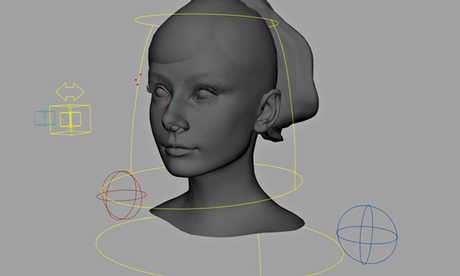
It’s not every day you’re asked to bring dead celebrities back from the grave, but in our line of work, it’s becoming more common. It’s something we at Framestore were asked to do when we resurrected Audrey HepburnTM for Galaxy’s chauffeur commercial.
Audrey represents heritage, classiness and elegance. So from a strategic and creative point of view, it made sense for Galaxy to communicate its “silk, not cotton” branding through these qualities. What was less clear, however, was just how we were meant to recreate an iconic and globally recognised face when the original footage exists at a resolution incompatible with today’s high standards.
We ended up completely recreating Audrey’s face in computer graphics (CG) – a feat never before achieved at such close-up scale. If this doesn’t sound like a big deal, it is. Replicating a photorealistic 100% CG human that stands up to close inspection is the mecca of visual effects (VFX). So this project was an industry first and took us to the edge of what’s possible.
Skin, eyes and facial hair are just too “perfect” when rendered through a computer. Crucial human subtleties, like the flicker of an eye, can also look robotic when computer-generated. So why go 100% CG?
We couldn’t take the easy option of filming a lookalike and disguising mismatched nuances through shadows and camera angles because, first, Audrey was the absolute star of the show and there was no hiding her in a dark corner; second, as the ultimate symbol of beauty, the likelihood of casting a near-perfect match was nil. So we went the whole hog and digitally recreated every millimetre of her face.
To get reference material of how Audrey would look and act in the script’s scenes, two body-doubles were cast: one to represent her minute 20-inch waist and another to convey as closely as possible her distinctive facial bone structure. Once shot, we’d have footage and data to augment with VFX.
Before the main shoot began on the Amalfi coast, we scanned the face-double using FACS (facial action coding system). This session captured a plethora of hi-res skin textures and more than 60 different facial expressions for animators to replicate when creating the CG Audrey.
Once this preparatory work was cracked, our VFX supervisors joined the production team in Italy. But there was no time to kick back and soak up la dolce vita. Instead, they tirelessly recorded lighting information – to help “bed in” VFX further down the line – and tracking data, to perfectly lock the actor’s body to our soon-to-be-made CG head. Without a perfect head joint, we’d get the dreaded “nodding dog” effect: the nadir of VFX that breaks reality.
Fortunately, we worked on the film Gravity’s VFX at the same time. In the film, Sandra Bullock’s body was CG but her face was live-action, so we’d already perfected an efficient method for joining head to body and could apply this time-saving technique to Audrey.
Once back at Framestore HQ, the lookalike’s FACS scan was used to build a CG facial rig: a replica of the lookalike’s face that provided the foundations for our digitally reimagined Audrey. To turn the lookalike’s CG face into an authentic-looking Audrey, we researched Hepburn’s back catalogue to identify the subtleties that make Audrey look like Audrey. But not just any old Audrey; our brief was to recreate a 19-year-old Ms Hepburn.
The next big challenge was to make the CG skin look real, the holy grail of CG. We experimented with a new renderer, Arnold, which hadn’t previously been used on a commercial. It paid off once we’d perfected the soft, translucent look of real skin. Combined with some cunningly created soft “peach fuzz” to break-up robotic perfection, we finally began to see an authentic-looking apparition.
Without access to geometrical data of Audrey’s face (if only they’d foreseen the future of VFX in the 1940s) recreating her as a CG entity was an inexact science, making it difficult to judge when we’d reached perfection. Our only option was good old-fashioned trial and error, persisting until everyone screamed: “That’s it!”
This final layer of perfection is the most demanding. Getting 95% of the images right took 50% of the time. Getting that extra 5%, the photorealism, consumed the second 50% of the schedule.
Although the ad first aired more than 18 months ago, it’s still enjoying international airtime today. It caused much debate in VFX circles, with many making misguided guesses about how we did it. But perhaps its most defining achievement is marking a milestone in the creation of photoreal CG humans. The repercussions are being felt far and wide.
Hollywood is quietly debating the consequences of photoreal CG actors and posthumous usage rights. Rumour even has it that savvy young A-listers are having their bodies scanned at various ages as a form of digital cryogenics. It’s no coincidence that shortly after resurrecting Audrey, Michael Jackson arose from the dead as a moon-walking hologram. Thanks to Audrey and Galaxy, it looks like CG humans are here to stay.
Ad facts
• Director: Daniel Kleinman, Rattling Stick
• Companies involved: Mars/Galaxy (brand), AMV BBDO (agency) and Framestore (VFX)
• Length of the project: two months’ R&D; five months’ post production
• Core team size: 12 artists
• Permissions: Audrey Hepburn™ © 2013 Sean Hepburn Ferrer and Luca Dotti. All rights reserved.
Mike McGee is co-founder and creative director at Framestore, which you can follow on Twitter @Framestore
To get weekly news analysis, job alerts and event notifications direct to your inbox, sign up free for Media Network membership.
All Guardian Media Network content is editorially independent except for pieces labelled ‘Advertisement feature’. Find out more here.
• This article was amended on 10 October to clarify that, in this context, Audrey HepburnTM is owned by Sean Hepburn Ferrer and Luca Dotti

